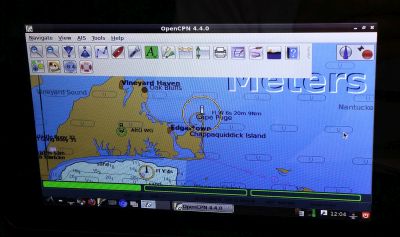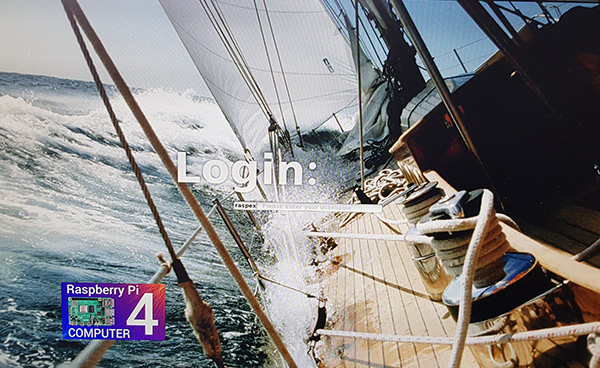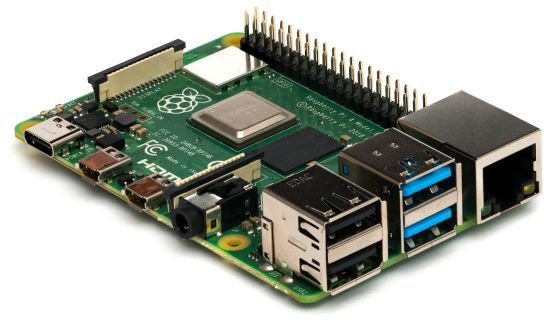 RaspEX Rpi4 – Build 210109 based on Ubuntu 20.04 Focal Fossa LTS (supported until April, 2025) – with OpenCPN 5.2.4 (latest stable version released 201018) – especially made for the new Raspberry Pi 4, but it can of course also be used on a Raspberry Pi 3 Model B+, Raspberry Pi 3 Model B and Raspberry Pi 2 Model B.
RaspEX Rpi4 – Build 210109 based on Ubuntu 20.04 Focal Fossa LTS (supported until April, 2025) – with OpenCPN 5.2.4 (latest stable version released 201018) – especially made for the new Raspberry Pi 4, but it can of course also be used on a Raspberry Pi 3 Model B+, Raspberry Pi 3 Model B and Raspberry Pi 2 Model B.
OpenCPN is a free software (GPLv2) project to create a concise chart plotter and navigation software, for use underway or as a planning tool. OpenCPN is developed by a team of active sailors using real world conditions for program testing and refinement.
REPLACEMENT
This build (210109) replaces build 190812. Ubuntu has been upgraded to version 20.04 and OpenCPN to version 5.2.4 – latest stable version. Build 210109 is made especially for the new Raspberry Pi 4, but can of course also be used on a Raspberry Pi 3 Model B+, Raspberry Pi 3 Model B and a Raspberry Pi 2 Model B.
The Desktop environment LXDE is used. The “Lightweight X11 Desktop Environment” is an extremely fast-performing and energy-saving desktop environment. LXDE uses less CPU and less RAM than other environments. It is especially designed for cloud computers with low hardware specifications, such as netbooks, mobile devices (e.g. MIDs) or older computers.
ABOUT RaspEX Build 210109
RaspEX is a Linux ARM system for Raspberry Pi 4, Pi 3 Model B, Model B+ and Pi 2 model B. It is based on Debian Buster (Debian 10), Focal Fossa (Ubuntu 20.04) and Linaro (Open Source software for ARM SoCs). In this new version (210109) I’ve installed OpenCPN 5.2.4.
Read this OpenCPN Review….
How do I install RaspEX with OpenCPN?
Just like any other Raspberry Pi system. I.e.: Unpack the downloaded ZIP file (raspex-raspex-ubuntu-20.04-opencpn-rpi4-lxde-1450mb-210109.zip) and transfer the IMAGE file raspex-ubuntu-20.04-opencpn-rpi4-lxde-4400mb-210109.img) to your Micro SD card of at least 8GB. For that you shall use Rufus 3.13, Win32 Disk Imager or Etcher in Windows.
Watch a YouTube video that shows the performance of OpenCPN on a Raspberry Pi…
NOTE: Please don’t ask me technical questions about how to use OpenCPN. I’m no expert on OpenCPN. You can search the Internet for answers. There is a lot written about OpenCPN and Raspberry Pi. The Cruisers Forum (World Cruising and Sailing Wiki) is a good starting point.
Kernel
Kernel 5.4.83-raspex-v7l is used.
How do I use RaspEX?
When you start up your Raspberry Pi Mini computer with RaspEX you will (after a few seconds) end up at SLiM‘s login page. The first time you start up RaspEX you shall log in as root with password root – see below under Important: First things to do. The password for raspex is raspex. When logged in as raspex you can use Sudo to become root. Example: sudo su and sudo pcmanfm. The password for root (superuser) is root. You can log out from LXDE and log in again as root (if you want). This is how it looks at SLiM‘s login page.
Important: First things to do
1) When you end up at Slim’s login page for the first time you shall log in as root with password root.
2) Start up a terminal and run the command ./resize_rootfs.sh or when logged in as user raspex sudo ./resize_rootfs.sh
Before doing that you can’t do much anything since the system is almost full (100 %) – watch this screenshot. That’s all you have to do. Just wait for the script to fix everything. If you use a SD card of 16 GB all the space on it will be used afterwards – watch this screenshot.
3) Run the command dphys-swapfile setup. A SWAP file of 2 GB will be created. Very useful if you want to run many programs at the same time. If you forget to run said command a SWAP file of 2 GB will be created automatically after a reboot. Watch this screenshot.
Root logins
You can log in as root with password root. You can of course also create a new ordinary user if you want. Command: sudo /usr/sbin/adduser MyNewUser. If you don’t want to be automatically logged in as raspex you shall edit /etc/slim.conf.
The Raspberry Pi 4 with 8GB RAM made in May 2020. It has:
- 2x USB 3.0 ports
- 2x USB 2.0 ports
- Gigabit Ethernet
- Power-over-Ethernet (this will require a PoE HAT)
- 40-pin GPIO header
- 2× micro-HDMI ports (up to 4Kp60 supported)
- H.265 (4Kp60 decode)
- H.264 (1080p60 decode, 1080p30 encode)
- OpenGL ES, 3.0 graphics
- DSI display port
- CSI camera port
- Combined 3.5mm analog audio and composite video jack
- Micro-SD card slot
- USB-C power
- 8GB RAM
Raspberry Pi 4: How much better is it than the Raspberry Pi 3 Model B+?
Raspberry Pi 3 Model 3 B+: How much better is it than the Raspberry Pi 3 Model B? The tiny computer is supposed to be faster and better in every way, including upgraded processor speed, wireless internet, and Ethernet connections.
Wireless connections
The Raspberry Pi 4, Pi 3 Model B and Pi 3 Model B+ computers has “built in” 802.11n Wireless LAN. Using Raspberry Pi 2 you have to have a Wireless USB Adapter. The only one which works for Raspberry Pi 2 is Edimax EW-7811Un (as far as I know).
About SSH, PuTTY, Samba, VNC4Server and VNC Viewer
SSH, Samba and VNC4Server are pre-installed in RaspEX Build 210109. You need to install PuTTy and and VNC Viewer in your Windows system if you want to connect to RaspEX/Raspberry Pi 4/3/2 from Windows. (Please read the developers information about how to configure PuTTy and VNC Viewer).
The 7″ Touchscreen Monitor for Raspberry Pi
To my great joy also this version of RaspEX work together with the 7″ Touchscreen Monitor for Raspberry Pi “out of the box”. Some fixes to be done:
#####################
Adding a virtual keyboard – Matchbox
Install it with sudo apt-get install matchbox-keyboard
Screenshot when Matchbox Keyboard is running
Rotate the touch screen
Depending on your display stand you might find that the LCD display defaults to being upside-down, you can fix this by rotating it in /boot/config.txt.
Add: lcd_rotate=2
Scrolling with a finger in Firefox and/or Chromium Browser
Can’t be fixed. It is also not working in Raspbian.
#############################
Advanced configuration with raspi-config
Run the command sudo raspi-config and you will get a menu with different configuration alternatives. You can for example expand the filesystem on the SD card. You can also enable an experimental GL driver for the Desktop. Perhaps useful if you have a big screen/monitor. You can also enable overscan. Useful if you use the 7″ touchscreen. See under Advanced Options.
Expand the filesystem on the SD card
If you install many new big programs and/or download large files (for example videos) you may run out of space on the SD card. That is best fixed by running the following command: sudo sh /root/resize_rootfs.sh
NOTE: That’s all you have to do. Just wait for the script to fix everything. If you use a SD card of 64 GB all the space on it will be used afterwards. See also above under Important: First things to do.
Installed packages
Besides from LXDE and OpenCPN a lot of ordinary Debian/Ubuntu packages are pre-installed. I can mention Firefox, Midori Private Browser, SMTube (YouTube browser which allows to browse, search and play YouTube videos), PulseAudio for better sound in YouTube and Synaptic Package Manager. Study the full package list of 210109…
Error no_pubkey when trying to upgrade the system
When you run the command sudo apt-get update it can happen that you can’t update the sources due to missing pub_keys. The solution is to run the following commands.
$ cd /var/lib/apt
$ sudo mv lists lists.old
$ sudo mkdir -p lists/partial
$ sudo apt-get update
After that you can run apt-get update with success even though you still will get the same “no_pubkey” errors.
Why shall I use RaspEX?
Eight Operating Systems are recommended by Raspberrypi.org. Among them Noobs, Raspbian (Debian Buster) and Snappy Ubuntu Core. RaspEX is faster (“fast as lightning”), more useful and more fun to use. (In my opinion). One member at this site thought that running RaspEX (for Raspberry Pi 2 Model B) was like running Raspberry Pi on “steroids“. RaspEX Build 210101, RaspEX Kodi Build 200726 and Build 210109 (current with OpenCPN) are of course even faster, especially if you run the systems on a Raspberry Pi 4 computer.
SCREENSHOTS
1. RaspEX Build 210109 using Bluetooth
2. RaspEX version 190812 running OpenCPN as the ordinary user raspex
3. RaspEX version 190812 running OpenCPN as root
4. OpenCPN 4.4.0 running on the 7″ Touchscreen Monitor for Raspberry Pi (old version OpenCPN)
5. OpenCPN Florida – Cape Canaveral (old version of OpenCPN)
6. OpenCPN New York – Approaches to New York (old version of OpenCPN)
7. OpenCPN Stockholm Archipelago (old version of OpenCPN)
Compatibility :: March 2021
Unfortunately not all systems made for Raspberry Pi 3 and 2 will run on the new Raspberry Pi 4 computer. They need to be upgraded with a new kernel. I therefore have to upgrade the systems I distribute. I.e. RaspEX, RaspEX with OpenCPN, exGENT, RaspEX BunsenLabs, RaspEX Kodi, RaspAnd Marshmallow, RaspAnd Nougat 7.1.2, RaspAnd Oreo 8.1, RaspAnd Pie, RaspAnd 10, RaspAnd 11 Build 210321, EXTON OpSuS Rpi, FedEX Rpi3 and RaspArch. I have until now (210321) only upgraded RaspAnd 11, RaspAnd 10, RaspEX, RaspEX Kodi, RaspArch, exGENT and RaspEX with OpenCPN. Read about the new Raspberry Pi 4.
Read about the new Raspberry Pi 4.
DOWNLOAD
Download raspex-ubuntu-20.04-opencpn-rpi4-lxde-1450mb-210109.zip from PayLoadz.com for 15 $
Raspberry Pi is a trademark of Raspberry Pi Foundation
Read about my Android-x86 Systems – 11, 10, Pie, Oreo, Nougat, Marshmallow, Lollipop and KitKat at andex.exton.net – latest is AndEX 11 (with GAPPS), AndEX 10 (with GAPPS) and AndEX Pie 9.0 (also with GAPPS)!
and
about my Android 15, 14, 13, 12, 11, 10, Pie, Oreo, Nougat, Marshmallow and Lollipop versions for Raspberry Pi 5, Pi 4 and Pi 3/2 at raspex.exton.se – latest is RaspAnd 15 (with GAPPS), RaspAnd 14 (also with GAPPS), 13 and 12 (without GAPPS), RaspAnd 11 (with GAPPS) and RaspAnd Oreo 8.1 (also with GAPPS)! 




